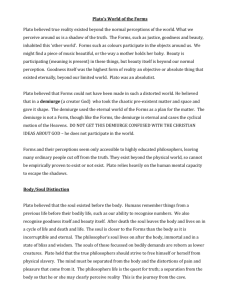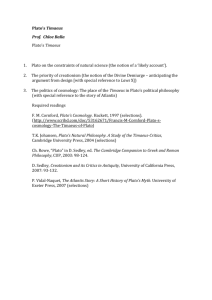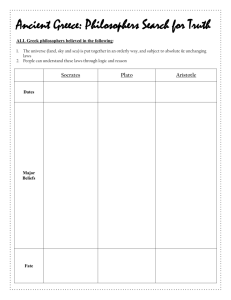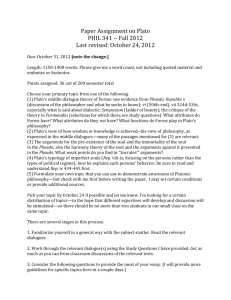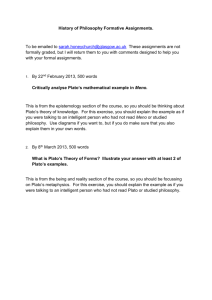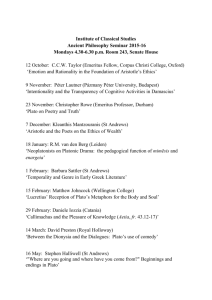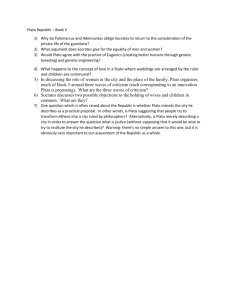PhilRelShanghai 10 Timaeus Plato`s theology The relevance of
advertisement
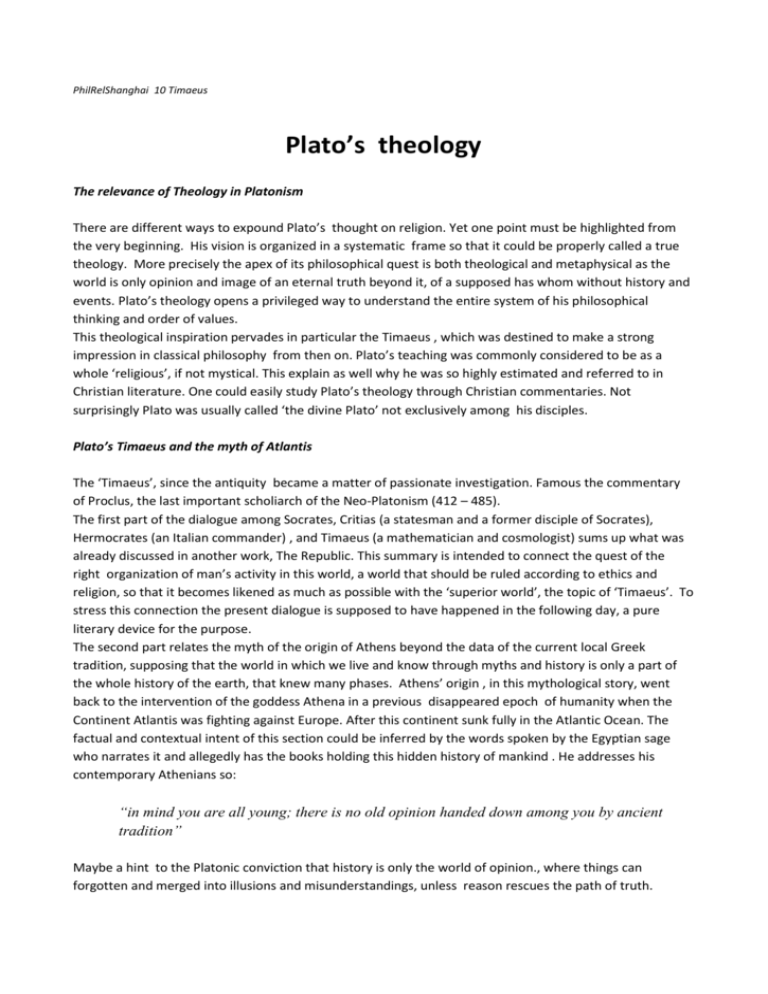
PhilRelShanghai 10 Timaeus Plato’s theology The relevance of Theology in Platonism There are different ways to expound Plato’s thought on religion. Yet one point must be highlighted from the very beginning. His vision is organized in a systematic frame so that it could be properly called a true theology. More precisely the apex of its philosophical quest is both theological and metaphysical as the world is only opinion and image of an eternal truth beyond it, of a supposed has whom without history and events. Plato’s theology opens a privileged way to understand the entire system of his philosophical thinking and order of values. This theological inspiration pervades in particular the Timaeus , which was destined to make a strong impression in classical philosophy from then on. Plato’s teaching was commonly considered to be as a whole ‘religious’, if not mystical. This explain as well why he was so highly estimated and referred to in Christian literature. One could easily study Plato’s theology through Christian commentaries. Not surprisingly Plato was usually called ‘the divine Plato’ not exclusively among his disciples. Plato’s Timaeus and the myth of Atlantis The ‘Timaeus’, since the antiquity became a matter of passionate investigation. Famous the commentary of Proclus, the last important scholiarch of the Neo-Platonism (412 – 485). The first part of the dialogue among Socrates, Critias (a statesman and a former disciple of Socrates), Hermocrates (an Italian commander) , and Timaeus (a mathematician and cosmologist) sums up what was already discussed in another work, The Republic. This summary is intended to connect the quest of the right organization of man’s activity in this world, a world that should be ruled according to ethics and religion, so that it becomes likened as much as possible with the ‘superior world’, the topic of ‘Timaeus’. To stress this connection the present dialogue is supposed to have happened in the following day, a pure literary device for the purpose. The second part relates the myth of the origin of Athens beyond the data of the current local Greek tradition, supposing that the world in which we live and know through myths and history is only a part of the whole history of the earth, that knew many phases. Athens’ origin , in this mythological story, went back to the intervention of the goddess Athena in a previous disappeared epoch of humanity when the Continent Atlantis was fighting against Europe. After this continent sunk fully in the Atlantic Ocean. The factual and contextual intent of this section could be inferred by the words spoken by the Egyptian sage who narrates it and allegedly has the books holding this hidden history of mankind . He addresses his contemporary Athenians so: “in mind you are all young; there is no old opinion handed down among you by ancient tradition” Maybe a hint to the Platonic conviction that history is only the world of opinion., where things can forgotten and merged into illusions and misunderstandings, unless reason rescues the path of truth. Timaeus monologue on the divine structure of the universe These two section can be considered an introduction to the core of the dialogue, namely the long monologue of Timaeus that will continue until the end without being interrupted, a kind of an accomplished treatise. Scholars speak of a full synthesis of the current science and philosophy , marked by an encyclopedic intention. The speech of Timaeus starts, significantly with this prayer: “All men, Socrates, who have any degree of right feeling, at the beginning of every enterprise, whether small or great, always call upon God. And we, too, who are going to discourse of the nature of the universe, how created or how existing without creation, if we be not altogether out of our wits, must invoke the aid of Gods and Goddesses and pray that our words may be acceptable to them and consistent with themselves. Let this, then, be our invocation of the Gods, to which I add an exhortation of myself to speak in such manner as will be most intelligible to you, and will most accord with my own intent” The introductory prayer of Timaeus creates a link between what philosophy yearns to know on religion by means of his rational investigation and what common people and local religious tradition practice and believe. This is testimony of the intention of Plato not to contradict the basic patrimony of the traditional religion, It not only a device of political caution, in order to avoid any charge of atheism. As we will see after, Plato claims to give the traditional gods a righter and more believable position than the current one, without negating the specific existence of their major traditional figures. Different levels of the ordained universe In the very beginning of his treatise Timaeus expounds what is going to be at stake. We find in this ‘positio quaestionis’ (how the question is or should be put), from the very beginning the main traits of Plato’s metaphysics and theology (the sentences are separated in order to emphasize their meaning): “First then, in my judgment, we must make a distinction and ask, What is that which always is and has no becoming; and what is that which is always becoming and never is? That which is apprehended by intelligence and reason is always in the same state; but that which is conceived by opinion with the help of sensation and without reason, is always in a process of becoming and perishing and never really is. Now everything that becomes or is created must of necessity be created by some cause, for without a cause nothing can be created.” It is maybe not exaggerated the opinion voiced by some scholars that the distinctions here expressed include the essence of Platonism: Distinction between what is eternal y incorruptible, that knows no change e is not generated from what is generated and knows change and corruption. Distinction from the beyond-world, that of the Ideas and eternal concepts, of the pure Intelligence, which owns the plenitude of being, which is only intelligible but not visible, and what belongs to the world of sensations, which needs to continuously change in order to realize its limited sphere of perfection along the time. Distinction between what is reached by the reason, t. is the knowledge of reality as an image of the beyond-world as far as it remains still present inside the world of sensations , and what is the knowledge that does not afford to go beyond opinions inside the visible world of sensations . Using a typical metaphysical language, Plato speaks of the superior world in terms of ‘always being without becoming’, because it simply ‘is’, it owns self-sufficiently its being, thus does not need to be generated , has no need of an external cause to support its existence It is wholly distinct from the other world which, on the contrary, needs a cause from outside to justify its existence , it does not own self-sufficiently its being, thus needs to receive generation, to be generated. Both are fixed in their order and distinct in their relation. One generated world or many generated worlds? The first world neither needs an external cause nor needs to generate. Why did God give life to the world? Plato seems to face the question from two different points of view. A necessary premise: the terms ‘give life’ is not metaphorical, as proved below: it pertains to the intrinsic essence of cosmos as it was put in way from the very beginning. The first point of view takes it start from the contemplation of the beauty of this created world ad concludes: such a beauty needs must find an adequate cause only supposing perfect original project in God himself, of which this world is just an image. The second starts from the perfect world of the divine ideas which governed the creation of this world. As they were perfect in beauty and goodness, they could operate nothing but consenting with them. Consequently, the ultimate to the above question is that God created not for necessity, but when He created he necessarily created a world likened to His beautiful and good essence. A large part of Timaeus is dedicated to explain and to prove how far this metaphysical likeness: It is then possible to infer from the beautiful and good quality present in this world the beauty and the goodness itself by means of the superior capacity of man’s reason to reach the original intention of God when he decided to create the universe: “…for the world is the fairest of creations and he is the best of causes. And having been created in this way, the world has been framed in the likeness of that which is apprehended by reason and mind and is unchangeable, and must therefore of necessity, if this is admitted, be a copy of something… 1 Let me tell you then why the creator made this world of generation. He was good, and the good can never have any jealousy of anything. And being free from jealousy, he desired that all things should be as like himself as they could be. This is in the truest sense the origin of creation and of the world, as we shall do well in believing on the testimony of wise men: God desired that all things should be good and nothing bad, so far as this was attainable”.2 The divine Demiurge The Demiurge is one of the most disputed figures of Plato’s system. He is introduced as a kind of metaphysical bridge between the first and the second world . He is the Ultimate Cause of the universe, God who from his Intellect, from his Ideas, without confusing them with what he created, remained unchangeable and nevertheless became ‘Father’ of all things outside of himself. We know him in the effects of his operation, but the proper knowledge of him is unattainable, for there is neither a proper language nor an appropriate thought to convey a precise concept of him: “… the father and maker of all this universe is past finding out; and even if we found him, to tell of him to all men would be impossible”3 Therefore he wanted am mediator to put in way the world of change, the cosmos, from the world of the unchangeable. Are there then two divine Beings? Or two different aspects of the same being, simply distinct by the perspective in which they are considered: the first that of God in Himself, the Divine Being without reference to the cosmos ; the second, the Demiurge, the Divine Being with reference with the shaping of the cosmos. The first takes what we could call a theistic feature; the second the interactive feature of what we usually call God, referred to human being. The Christian tradition used to see in the Demiurge a presentiment of the Logos, the second person of the Trinity. The divine making of the universe Timaeus, when tries to imagine God , the Demiurge, in the process of creation presents him reasoning about the best way to build up the most perfect world. He thought that nothing among the visible and corporeal things was better than a being provided with intellect. To this purpose he created the Soul of the Universe: “Now the deeds of the best could never be or have been other than the fairest; and the creator, reflecting on the things which are by nature visible, found that no unintelligent creature taken as a whole was fairer than the intelligent taken as a whole; and that intelligence could not be present in anything which was devoid of soul. For which reason, 1 Timaeus, V. 2 Ib., VI Ib., V. 3 when he was framing the universe, he put intelligence in soul, and soul in body, that he might be the creator of a work which was by nature fairest and best. Wherefore, using the language of probability, we may say that the world became a living creature truly endowed with soul and intelligence by the providence of God.”4 Consistent with his premises, Plato, when he speaks of this world, he uses the probability criterion. In this world is possible only the knowledge through senses. This remarks the qualitative distance between the Demiurge and the Soul of the Universe. The Demiurge has nothing to do with what is sensible as it happens in the Soul of the Universe. Only one Cosmos and One Soul of the Cosmos In contrast with the philosophers who maintained the possibility of many, infinite worlds on the basis of a material principle, a principle based on quantity, Plato supposed that the only possible divine project to create a universe ought to be at His image. This involved the qualitative principle of perfection. As God is the Unique Being, the framing of the cosmos ought to liken him in oneness of his divine author: “ … the Deity, intending to make this world like the fairest and most perfect of intelligible beings, framed one visible animal comprehending within itself all other animals of a kindred nature. Are we right in saying that there is one world, or that they are many and infinite? There must be one only, if the created copy is to accord with the original. For that which includes all other intelligible creatures cannot have a second or companion; in that case there would be need of another living being which would include both, and of which they would be parts, and the likeness would be more truly said to resemble not them, but that other which included them. In order then that the world might be solitary, like the perfect animal, the creator made not two worlds or an infinite number of them; but there is and ever will be one only-begotten and created heaven.”5 Why the perfect shape of the Soul of the cosmos was spherical Besides the Soul was framed in the most perfect, harmonious, imperishable shape, that of a sphere. The Soul is always considered as an ‘animal’, a term which does not take the current meaning but instead that of ‘living being’. Thus Plato ventures some parallels between the cosmos and the living beings which might surely appear almost puzzling. The reasons put forward to show the grounds that induced the Demiurge to choose this specific frame for the Soul of the cosmos are so displayed by Plato: “ … he gave to the world the figure which was suitable and also natural. Now to the animal which was to comprehend all animals, that figure was suitable which comprehends within itself all other figures. Wherefore he made the world in the form of a globe, round as from a lathe, having its extremes in every direction equidistant from the centre, the most perfect and the most like itself of all figures; for he considered that the like is infinitely fairer than 4 5 Ib. VI. Ib. the unlike. This he finished off, making the surface smooth all around for many reasons; in the first place, because the living being had no need of eyes when there was nothing remaining outside him to be seen; nor of ears when there was nothing to be heard; and there was no surrounding atmosphere to be breathed; nor would there have been any use of organs by the help of which he might receive his food or get rid of what he had already digested, since there was nothing which went from him or came into him: for there was nothing beside him. Of design he was created thus, his own waste providing his own food, and all that he did or suffered taking place in and by himself. For the Creator conceived that a being which was self-sufficient would be far more excellent than one which lacked anything; and, as he had no need to take anything or defend himself against any one, the Creator did not think it necessary to bestow upon him hands: nor had he any need of feet, nor of the whole apparatus of walking; but the movement suited to his spherical form was assigned to him, being of all the seven that which is most appropriate to mind and intelligence; and he was made to move in the same manner and on the same spot, within his own limits revolving in a circle”.6 On the body of the Soul perpetually thriving, while its body consisted of the four basic elements: fire, earth, water and air. Plato wants to prove his assertions, as often in the Timaeus, with precise arithmetical and geometrical figures. He is deeply convinced that it belongs to the rational structure of the universe that allows to realize it is the image of the divine perfection. See, for instance the following figures intended to stress the harmonious nature of the Soul’s structure both in the composition of its primordial elements and in its supposed mutual proportions: “Now that which is created is of necessity corporeal, and also visible and tangible. And nothing is visible where there is no fire, or tangible which has no solidity, and nothing is solid without earth. Wherefore also God in the beginning of creation made the body of the universe to consist of fire and earth. But two things cannot be rightly put together without a third; there must be some bond of union between them. And the fairest bond is that which makes the most complete fusion of itself and the things which it combines; and proportion is best adapted to effect such a union. For whenever in any three numbers, whether cube or square, there is a mean, which is to the last term what the first term is to it; and again, when the mean is to the first term as the last term is to the mean-then the mean becoming first and last, and the first and last both becoming means, they will all of them of necessity come to be the same, and having become the same with one another will be all one. If the universal frame had been created a surface only and having no depth, a single mean would have sufficed to bind together itself and the other terms; but now, as the world must be solid, and solid bodies are always compacted not by one mean but by two, God placed water and air in the mean between fire and earth, and made them to have the same proportion so far as was possible (as fire is to air so is air to water, and as air is to water so is water to earth); and thus he bound and put together a visible and tangible heaven. And for these reasons, and out of such elements which are in number four, the body of the world was created, and it was 6 Ib., VII harmonized by proportion, and therefore has the spirit of friendship; and having been reconciled to itself, it was indissoluble by the hand of any other than the framer.”7 The Soul of the Universe is really, according to Plato a ‘Living reason’8, so that it results of a synthesis of intelligible and sensible, of eternity and time, of changeable and unchangeable, because it is eternal in change following regular rules of measure and proportions, t. is scanned by time: “When the father creator saw the creature which he had made moving and living, the created image of the eternal gods, he rejoiced, and in his joy determined to make the copy still more like the original; and as this was eternal, he sought to make the universe eternal, so far as might be. Now the nature of the ideal being was everlasting, but to bestow this attribute in its fullness upon a creature was impossible. Wherefore he resolved to have a moving image of eternity, and when he set in order the heaven, he made this image eternal but moving according to number, while eternity itself rests in unity; and this image we call time.”9 The cosmic and mythological Gods From this point onward, Plato expounds the making of the cosmos along with the gradual shaping of creatures, which respond to the idea the divine operator (Demiurge) has conceived and stated for each of them under the universal animating power of the Soul. As it not possible to assign to the eternal God in his unchangeable perfection any category contrasting with these attributes, it was necessary to create time and space, for the sensible cosmos which needs them, because it is the world of change. Thus the Demiurge created the stars and the planets in order to state measure for what is eternally changing. Even if this kind of eternity in quite different, yet the cosmos is somehow the image of the superior world. Besides the demiurge provided the cosmos with the highest visible element, the fire, and let the cosmos to assume the perfect shape, the sphere. These creatures are called by Plato Gods: “Of the heavenly and divine, he created the greater part out of fire, that they might be the brightest of all things and fairest to behold, and he fashioned them after the likeness of the universe in the figure of a circle, and made them follow the intelligent motion of the supreme, distributing them over the whole circumference of heaven, which was to be a true cosmos or glorious world spangled with them all over. And he gave to each of them two movements: the first, a movement on the same spot after the same manner, whereby they ever continue to think consistently the same thoughts about the same things; the second, a forward movement, in which they are controlled by the revolution of the same and the like; but by the other five motions they were unaffected, in order that each of them might attain the highest perfection. And for this reason the fixed stars were created, to be divine and eternal animals, ever-abiding and revolving after the same manner and on the same spot; 7 Ib. VII Ζοων Νοητικόν. 9 Ib. X 8 and the other stars which reverse their motion and are subject to deviations of this kind, were created in the manner already described”10 The fact that Plato recognized the divine nature of stars and skies, became a matter of sharp contention with Christianity. All the more so because some Christian thinkers appreciated the ‘theological’ framework of his philosophy and even chose him as the most preferable partner of a religious confrontation. However they could not accept that the uniqueness of God so highly stressed on one hand by Plato, might on the other be dismantled by assigning the divine attributes to what they considered – according to the Bible - pure material beings, creatures as well. The contention was even sharper when Plato acknowledged the traditional deities being included inside a providential cosmic structure, although they were, to a certain extent, purified of their more disputable mythological functions. Although Plato agrees with a critical inquiry on the origin of such deities, yet he concludes that they must be accepted and venerated in obedience and observance of the current laws of society. The power of the tradition in this case comes out in full evidence. Also this point became a matter of strong contention with Christians all along the first centuries of the CE. “To know or tell the origin of the other divinities is beyond us, and we must accept the traditions of the men of old time who affirm themselves to be the offspring of the gods-that is what they say-and they must surely have known their own ancestors. How can we doubt the word of the children of the gods? Although they give no probable or certain proofs, still, as they declare that they are speaking of what took place in their own family, we must conform to custom and believe them. In this manner, then, according to them, the genealogy of these gods is to be received and set forth. Oceanus and Tethys were the children of Earth and Heaven, and from these sprang Phorcys and Cronos and Rhea, and all that generation; and from Cronos and Rhea sprang Zeus and Here, and all those who are said to be their brethren, and others who were the children of these.” 11 Using a current typology of the rhetoric schools, Plato introduces directly on the mouth of the Demiurge a speech directed to the traditional deities. In this speech they are included in a providential design, t. is they are reinterpreted according the rational design Plato assigns to the cosmos: “Now, when all of them, both those who visibly appear in their revolutions as well as those other gods who are of a more retiring nature, had come into being, the creator of the universe addressed them in these words: ‘Gods, children of gods, who are my works, and of whom I am the artificer and father, my creations are indissoluble, if so I will. All that is bound may be undone, but only an evil being would wish to undo that which is harmonious and happy. Wherefore, since ye are but creatures, ye are not altogether immortal and indissoluble, but ye shall certainly not be dissolved, nor be liable to the fate of death, having in my will a greater and mightier bond than those with which ye were bound at the time of 10 11 Ib. XII. Ib. XIII. your birth. And now listen to my instructions:-Three tribes of mortal beings remain to be created-without them the universe will be incomplete, for it will not contain every kind of animal which it ought to contain, if it is to be perfect. On the other hand, if they were created by me and received life at my hands, they would be on an equality with the gods. In order then that they may be mortal, and that this universe may be truly universal, do ye, according to your natures, betake yourselves to the formation of animals, imitating the power which was shown by me in creating you. The part of them worthy of the name immortal, which is called divine and is the guiding principle of those who are willing to follow justice and you-of that divine part I will myself sow the seed, and having made a beginning, I will hand the work over to you. And do ye then interweave the mortal with the immortal, and make and beget living creatures, and give them food, and make them to grow, and receive them again in death’."12 The matter, an unsolved problem This passage from the Ideal frame of the universe, from the mere possibility of its existence to the accomplished project in a real world through the mediation of the Demiurge evokes one of the various unsolved problems of Timaeus, the problem of the ‘matter’. From what actually did God start after having decided to give life to the universe? “ … finding the whole visible sphere not at rest, but moving in an irregular and disorderly fashion, out of disorder he brought order, considering that this was in every way better than the other.” These words presuppose that in the very beginning the Demiurge found something ‘at disposal’. Inside his system Plato realizes that something continues to be radically unattainable, untranslatable in rational language. As we will se below, at the opposite extreme also God could not be adequately said and spoken out, even if it is necessary to presuppose his existence and to define his nature by reasonable approach. Going back to the open question of the matter, that the Demiurge needed outside of himself in order to exert his creative work. Something necessary in order to render possible the shaping of all what had to come to existence. Something to shape. Creation, according to Plato is shaping, giving form to what can be shaped, without having already shape. Plato covers it with the words of ‘necessity’ or of ‘matter’. The question must take this way: what was it that was receiving by the Demiurge the forms imitating the eternal perfect God’s Ideas? Did something exist already before God created the universe, the cosmos, which means just ‘ordered whole’? Definitely: how to grasp in concepts what resists any definition? It was not the nothing. Plato is inclined to think of it as not-order, t. i. the chaos. the unordered ‘what’. Thus in his metaphysical understanding of reality he outlines no more only two degrees, namely a) the superior world of God, of the perfect Ideas and divine reason b) the world here below, the image of the world up above He supposes a third metaphysical level of reality, that of the matter: “This new beginning of our discussion of the universe requires a fuller division than the former; for then we made two classes, now a third must be revealed. The two sufficed for the former discussion: one, which we assumed, was a pattern intelligible and always the same; 12 Ib., and the second was only the imitation of the pattern, generated and visible. There is also a third kind which we did not distinguish at the time, conceiving that the two would be enough. But now the argument seems to require that we should set forth in words another kind, which is difficult of explanation and dimly seen. What nature are we to attribute to this new kind of being? We reply, that it is the receptacle, and in a manner the nurse, of all generation. I have spoken the truth; but I must express myself in clearer language, and this will be an arduous task for many reasons, and in particular because I must first raise questions concerning fire and the other elements, and determine what each of them is; for to say, with any probability or certitude, which of them should be called water rather than fire, and which should be called any of them rather than all or some one of them, is a difficult matter. How, then, shall we settle this point, and what questions about the elements may be fairly raised? In the first place, we see that what we just now called water, by condensation, I suppose, becomes stone and earth; and this same element, when melted and dispersed, passes into vapour and air. Air, again, when inflamed, becomes fire; and again fire, when condensed and extinguished, passes once more into the form of air; and once more, air, when collected and condensed, produces cloud and mist; and from these, when still more compressed, comes flowing water, and from water comes earth and stones once more; and thus generation appears to be transmitted from one to the other in a circle. Thus, then, as the several elements never present themselves in the same form, how can any one have the assurance to assert positively that any of them, whatever it may be, is one thing rather than another? No one can. But much the safest plan is to speak of them as follows:-Anything which we see to be continually changing, as, for example, fire, we must not call "this" or "that," but rather say that it is "of such a nature"; nor let us speak of water as "this"; but always as "such"; nor must we imply that there is any stability in any of those things which we indicate by the use of the words "this" and "that," supposing ourselves to signify something thereby; for they are too volatile to be detained in any such expressions as "this," or "that," or "relative to this," or any other mode of speaking which represents them as permanent. We ought not to apply "this" to any of them, but rather the word "such"; which expresses the similar principle circulating in each and all of them; for example, that should be called "fire" which is of such a nature always, and so of everything that has generation. That in which the elements severally grow up, and appear, and decay, is alone to be called by the name "this" or "that"; but that which is of a certain nature, hot or white, or anything which admits of opposite equalities, and all things that are compounded of them, ought not to be so denominated. Let me make another attempt to explain my meaning more clearly. Suppose a person to make all kinds of figures of gold and to be always transmuting one form into all the rest-somebody points to one of them and asks what it is. By far the safest and truest answer is, That is gold; and not to call the triangle or any other figures which are formed in the gold "these," as though they had existence, since they are in process of change while he is making the assertion; but if the questioner be willing to take the safe and indefinite expression, "such," we should be satisfied. And the same argument applies to the universal nature which receives all bodies-that must be always called the same; for, while receiving all things, she never departs at all from her own nature, and never in any way, or at any time, assumes a form like that of any of the things which enter into her; she is the natural recipient of all impressions, and is stirred and informed by them, and appears different from time to time by reason of them. But the forms which enter into and go out of her are the likenesses of real existences modelled after their patterns in wonderful and inexplicable manner, which we will hereafter investigate. For the present we have only to conceive of three natures: first, that which is in process of generation; secondly, that in which the generation takes place; and thirdly, that of which the thing generated is a resemblance. And we may liken the receiving principle to a mother, and the source or spring to a father, and the intermediate nature to a child; and may remark further, that if the model is to take every variety of form, then the matter in which the model is fashioned will not be duly prepared, unless it is formless, and free from the impress of any of these shapes which it is hereafter to receive from without. For if the matter were like any of the supervening forms, then whenever any opposite or entirely different nature was stamped upon its surface, it would take the impression badly, because it would intrude its own shape. Wherefore, that which is to receive all forms should have no form; as in making perfumes they first contrive that the liquid substance which is to receive the scent shall be as inodorous as possible; or as those who wish to impress figures on soft substances do not allow any previous impression to remain, but begin by making the surface as even and smooth as possible. In the same way that which is to receive perpetually and through its whole extent the resemblances of all eternal beings ought to be devoid of any particular form. Wherefore, the mother and receptacle of all created and visible and in any way sensible things, is not to be termed earth, or air, or fire, or water, or any of their compounds or any of the elements from which these are derived, but is an invisible and formless being which receives all things and in some mysterious way partakes of the intelligible, and is most incomprehensible. In saying this we shall not be far wrong ; as far, however, as we can attain to a knowledge of her from the previous considerations, we may truly say that fire is that part of her nature which from time to time is inflamed, and water that which is moistened, and that the mother substance becomes earth and air, in so far as she receives the impressions of them” This problem was destined to be one of the most relevant in the debate between Christians and Platonists as the Biblical tradition started from the nothing when spoke of creation, that is creation in proper terms meant for Christians exactly the passage from nothing to being. This is not the case for Plato and Platonists. Creation means ‘giving order’ to what already exists. Christian saw in this assumption Significantly Plato goes back to the question at the end of the Timaeus when he discusses of the primordial ‘matter’ of the universe and contrasts the opinion of some pre-socratic philosophers who explained it referring to different basic and indivisible elements (earth, water, air, fire or others like that). Plato contends that these are the ultimate, the metaphysic answer to the question: is there any start of being for what does exist, supposing that it cannot be the matter itself for the matter has no reason nor possible project for its becoming distinct and ordered beings like the universe. On the other hand God as well seems to have no possible relation with the matter because He has no link with what has no shape of form. But the matter is in principle ‘without any shape’, It cannot be conceivable by the reason. An God id pure reason. How to conceive what is unconceivable? Plato looks like to have no reason for what is not reasonable because what is not reasonable is simply not being. disposal’In Timaeus explains the process in terms of ‘imitation’: the sensible world , the world where things are eternally generated comes out by imitation of the invisible, ingenerated, eternal world. Not by generation, but just by imitation, that consents the world of perfection not to be affected by imperfection. And this is precisely the work of the Demiurge. We could start by saying that the most consequent proposition of Plato’s attempt to speak of God is the acknowledgment that No language, no thought because our knowledge is definitely marked by precise boundaries: There a world ever enjoying the fullness of being, the world of the pure self-subsistent ideas, and therefore is needy of no change. It is attainable only by reason, even if it is invisible There is a world ever involved in change because it has no fullness of being: it is the world where reigns the opinion, even if it is visible This is the basic metaphysical presupposition of Plato’s inquiry on the nature of God.
